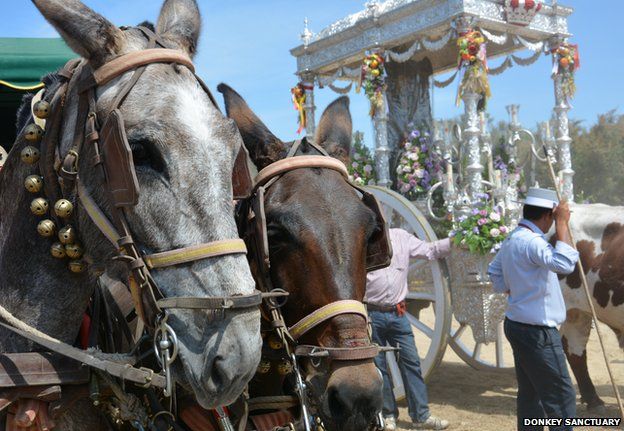Can Spain save horses on Andalusia pilgrimage from dying?
- Published

Each year a small hamlet in rural Andalusia welcomes a staggering one million pilgrims to its sandy streets.
Many walk for days in sweltering conditions to reach El Rocio, normally home to fewer than 2,000 inhabitants. Others ride horses or travel in carts pulled by oxen or mules.
They are all brought together by the collective desire to worship a 13th Century effigy known as the Virgin of Rocio.
At first glance, it looks like a ritual that has gone unchanged for centuries.
But in recent years - behind the flamenco dresses, religious fervour and cold beer - there has been a cloud of controversy concerning the welfare of the animals taking part.
Since 2000, more than 230 horses, mules and oxen have perished during the week-long festivities, and many more have suffered non-fatal injuries.
In 2008 the number of equine deaths peaked at 25, causing an outcry among animal welfare charities which continue to highlight the fatalities.
The pilgrimage to El Rocio takes place in the late spring Andalusian sunshine, with temperatures already reaching more than 35C.
Between 12,000 and 15,000 horses, mules and donkeys and their charges pick their way across the region in large religious groups called "hermandades", pitching camp along route.
These extreme conditions and long days directly contribute to the equine deaths. Horses are most vulnerable because of a more sensitive disposition and as they are susceptible to colic, which can prove fatal.
"It's unavoidable that some animals die during the pilgrimage, despite the best efforts of their owners," says Lt Jose Alfaro, the head of Seprona, the wildlife and environmental protection arm of the Civil Guard in the province of Huelva.
He does, however, acknowledge that animals rented out are most at risk of mistreatment.
"The rented horses are often very old, injured or lame and their owners less concerned about their care," he says.
"Just last year pilgrims called Seprona to report an unidentified horse cadaver left abandoned en route.
"Our officers tracked down the horse's owner via its chip and discovered that it had been lent to an acquaintance, who failed to report its death when it had died along the way, which in itself is an offence."
Veterinary treatment
Despite the continuing problems, this year's pilgrimage saw a significant drop in fatalities.
The eight deaths were the lowest since 2002.
That could in part be due to the cooler temperatures this year, but it could also be down to police and local authorities cooperating with animal welfare charities, which set up an onsite veterinary hospital for the first time.
The Refugio del Burrito charity and the UK's Donkey Sanctuary sent a 30-strong team of vets and animal welfare specialists, who treated almost 200 animals affected by injuries, exhaustion and dehydration.
Many of the animals had suffered neglect and cruelty, and several considered to be in danger were taken away.
Lt Alfaro said the "Romeros" (the Spanish name for pilgrims to El Rocio) had previously been suspicious of the charity volunteers "wearing blue t-shirts".
"This year most of them welcomed their presence and voluntarily brought their injured animals to the hospital for treatment," he said.
'Success'
But there was still a significantly high number of cases of cruelty among rented horses and mules.
In one of the worst cases, two hired mules collapsed after 16 hours of carrying around revellers without rest.
The animals were treated by the charity vets and, with the assistance of the local authorities, were confiscated from their owner, who is now facing a fine.
But Lt Alfaro is buoyed by this year's "successes".
"I think it's wrong to focus on the deaths during El Rocio," he says.
"One should concentrate on the general impression of the animals' welfare, which this year has been much better.
"This year we've had no criminal offences for animal cruelty where an animal's life has been in danger, but 29 individuals have been reported for lesser cases of ill treatment or neglect.
"Next year we hope to bring that figure down even further."
- Published13 July 2014